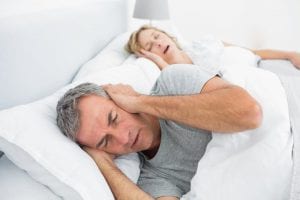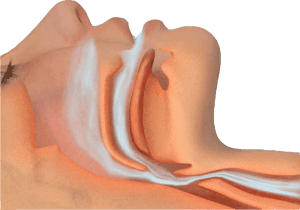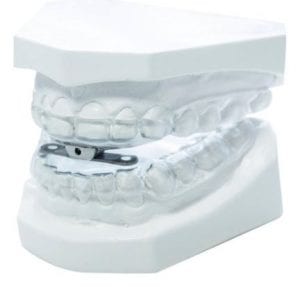What is snoring?
Sleep related breathing disorders demonstrate, to varying degrees, the collapsibility of the airway. With simple palatal snoring, there is no full obstruction of the airway – the noise is simply the vibrations of soft tissue. Whilst this often has little impact on the snorer, some do wake feeling unrefreshed, suffer headaches and a tenderness in the upper airway. More often, it is those dear ones within close proximity that are profoundly affected.

Daytime sleepiness
Excessive daytime sleepiness (EDS) can result from insufficient oxygen entering the body and poor quality sleep caused by multiple wakings. Effects of EDS include an inability to concentrate, poor memory, reduction in performance and, in extreme cases, can lead to the sufferer falling asleep unexpectedly. Severe sleepiness has even been found to increase the chances of having an accident whilst driving by seven times.
Sleep apnoea
EDS can be a result of obstructive sleep apnoea, a more severe collapsing of the airway in which it is obstructed for multiple periods of time during sleep. Both in the form of a total pause or a significant shallowing of breath, oxygen levels dip and can result in a multitude of symptoms: extreme tiredness, snoring, abnormal movements whilst sleeping, headaches, and psychological issues to name a few.

Proven solutions
it is not uncommon for those suffering from snoring to consult their GP for advice. This typically leads to suggested lifestyle changes, including: weight loss, different sleeping positions, staying well hydrated and avoiding alcohol. Whilst these are important and will likely have a positive impact on snoring, they are unlikely to completely eradicate the problem – especially in the case of OSA.
The use of MAS has been clinically proven to have a significant impact on snoring. As part of the screening process, we will ask you to complete a short questionnaire that assesses the quality of your sleep, as well as your level of tiredness in certain scenarios. There is also a section for your bed partner, if you have one, to complete. The results will be used to rule out OSA by determining your risk level. If you are suspected of suffering from OSA, we will refer you on to your GP for further investigation – a non-invasive sleep study, which will accurately measure your sleeping patterns and oxygen saturation levels.There are a number of solutions for both snoring and sleep apnoea. Mandibular Advancement Splints (MAS) are commonly used for both conditions, gently holding the lower jaw forward to keep the airway open.

For severe sleep apnoea (typically tested in a sleep clinic, but can also be done in your own home), Continuous Positive Airway Pressure (CPAP) is recommended and offers the highest clinical success. For patients that cannot get on with CPAP and for moderate sufferers, (less than 30 interruptions an hour), a splint is the most common treatment of choice – highly effective, less expensive and more patient friendly.
Customised for each patient, there are a number of splints of the market. Now made in the UK (Sheffield) using a unique manufacturing process, Sleepwell has been shown to be the most clinically successful.

Recent Comments